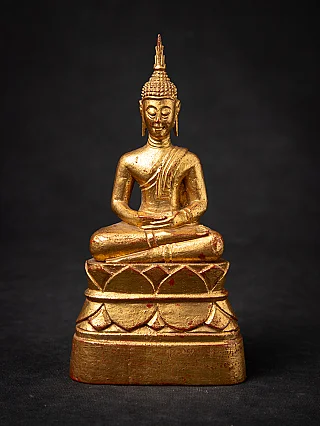Ayutthaya Period Buddha statue

Exclusive pieces from Thailand
From 1350 to 1767, the Ayutthaya period is significant in Thai history and Buddhist art. Named after the prosperous kingdom of Ayutthaya, this period saw the flourishing of unique styles and forms in Buddha statuary. It was heavily influenced by preceding Sukhothai and Khmer aesthetics yet distinct in its interpretation of religious art. Ayutthaya Buddha statues are renowned for their intricate craftsmanship, serene expressions, and the profound symbolism they hold in Buddhist culture. Understanding these statues offers insight into the beliefs, practices, and artistry of one of Thailand's most influential eras.
Origins and Historical Context of the Ayutthaya Period

The Ayutthaya kingdom was founded by King Ramathibodi I in 1350 and quickly rose as a major power in Southeast Asia. Its location along significant trade routes allowed Ayutthaya to establish relationships with China, India, Persia, and even European nations, enriching the kingdom's cultural and artistic influences. Buddhism was central to the Ayutthaya kingdom's spiritual and political identity, with the monarchy supporting Buddhist temples, monasteries, and art as expressions of their faith and power. This royal patronage enabled artists and sculptors to develop and refine a unique style that reflected both devotion and royal grandeur, with Buddha statues being the most revered form of this artistry.
Distinctive Features of Ayutthaya Buddha Statues
Ayutthaya Buddha statues are celebrated for their unique characteristics that set them apart from those of other Thai periods. They often feature elements drawn from various artistic traditions, including the Sukhothai style's gracefulness and the Khmer style's regal qualities, yet with distinct features that symbolize the Ayutthaya kingdom's spiritual ideals.
- Facial Features: Ayutthaya Buddha statues are known for their gentle yet authoritative expressions. The faces are often rounder and fuller than those seen in earlier Sukhothai statues, symbolizing compassion and wisdom. Eyebrows are finely arched, and the eyes are half-closed, expressing introspective calm. The mouth is typically small, with lips curved slightly upwards, giving the Buddha a serene smile. This distinctive look is meant to represent the Buddha's all-encompassing compassion and his transcendence of worldly suffering.
- Body Structure and Posture: The body structure of Ayutthaya Buddha statues is usually more robust and muscular than those from the Sukhothai period. This is intended to emphasize the Buddha's strength and inner power, aligning with the Ayutthaya belief in the Buddha's capability to overcome the obstacles of worldly life. The statues are often depicted in either a seated or standing position. The Buddha is usually depicted in the Bhumisparsha Mudra (earth-touching gesture) in seated statues, symbolizing his enlightenment under the Bodhi tree. Standing statues from this period often exhibit the Abhaya Mudra (gesture of fearlessness) or the Vitarka Mudra (teaching gesture), symbolizing protection, guidance, and wisdom.
- Attire and Ornamentation: The attire of Ayutthaya Buddha statues is characterized by intricate detailing, often with the robe cascading over one shoulder in elegant folds, unlike the more straightforward attire seen in earlier periods. These robes frequently include delicate floral and geometric patterns engraved on the surface, highlighting the statue's luxurious appeal and the craftsmanship of Ayutthaya artisans. This elaborate detailing reflects the royal patronage of the Ayutthaya kingdom and its emphasis on displaying the Buddha's dignity and majesty.
- Symbolic Headdress and Usnisha: Another significant feature of Ayutthaya Buddha statues is the Usnisha, the cranial bump symbolizing the Buddha's spiritual wisdom. In Ayutthaya statues, this feature is often depicted as a lotus bud or a flame-like structure, symbolizing enlightenment. This is often complemented by a crown or headdress adorned with intricate designs, underscoring the spiritual authority of the Buddha. This adaptation reflects Buddhist symbolism and the influence of the Khmer Empire, emphasizing ornate headdresses in statuary.
- Material and Techniques: Ayutthaya artisans utilized bronze, gold leaf, and stucco to craft Buddha statues, reflecting both spiritual symbolism and the wealth of the Ayutthaya kingdom. The statues were often gilded with gold, a practice that symbolized purity, enlightenment, and the transcendence of earthly wealth. The casting techniques used in this period allowed artisans to create statues with refined details, ensuring that each sculpture became a captivating work of spiritual significance and artistic mastery.
Symbolism in Ayutthaya Buddha Statues
The symbolism embedded in Ayutthaya Buddha statues goes beyond their physical features. The statues reflect the Ayutthaya kingdom's religious values and the role of Buddhism as a guide in both spiritual and worldly life.
- Compassion and Wisdom: The Buddha's gentle smile and serene expression convey the ideals of compassion and wisdom, encouraging followers to cultivate these virtues.
- Protection and Guidance: The Abhaya Mudra (fearlessness gesture) seen in standing statues represents protection from fear and evil, as a reminder of the Buddha's role as a spiritual guide.
- Enlightenment: The flame-like Usnisha and lotus-shaped headdresses symbolize the enlightenment achieved by the Buddha, reinforcing the ultimate goal of Buddhist practice.
- Spiritual Power: The muscular build and detailed robes symbolize the Buddha's inner strength and authority, encouraging practitioners to find strength in their faith.
Influence of Ayutthaya Buddha Statues on Later Periods
The Ayutthaya period's artistic style had a lasting impact on later periods of Thai Buddha sculpture, particularly the following Rattanakosin period. The intricate detailing, rounded facial features, and the expressive use of symbolism in Ayutthaya statues became defining characteristics in Thai Buddhist art, influencing generations of artisans. Many Buddha statues crafted in the Rattanakosin period emulate Ayutthaya's emphasis on elaborate detailing and spiritual expression, reflecting the enduring legacy of Ayutthaya's craftsmanship.
Ayutthaya Buddha Statues in the Modern Era
Today, collectors and Buddhist practitioners worldwide highly value Ayutthaya Buddha statues for their historical significance, artistic beauty, and spiritual resonance. They are often housed in museums, private collections, and religious institutions, where they continue to inspire and remind viewers of the Ayutthaya kingdom's devotion to Buddhism. Collecting Ayutthaya Buddha statues provides a glimpse into Thailand's rich cultural heritage and an opportunity to connect with the timeless spiritual teachings embodied in these remarkable sculptures.
Share this page











































